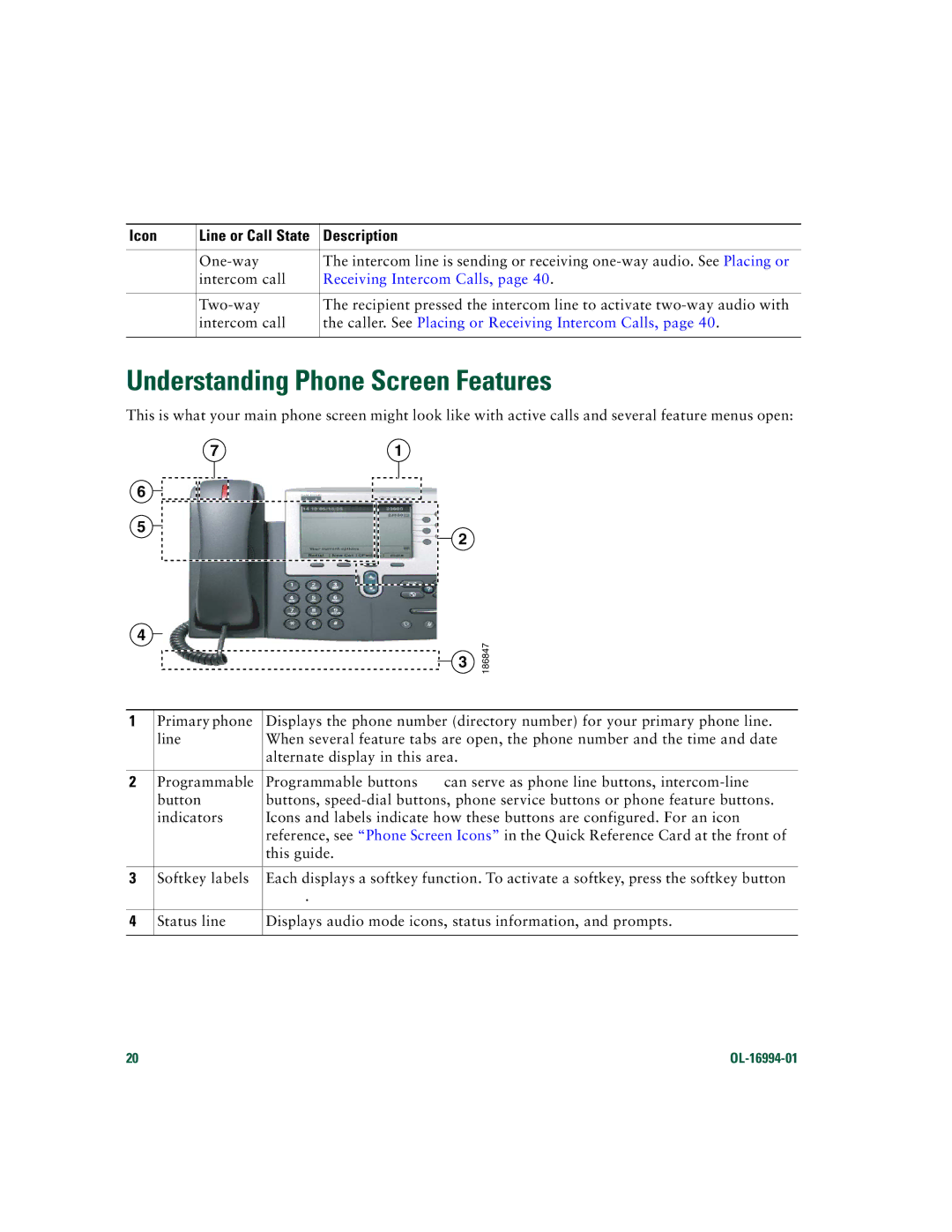Americas Headquarters
Page
Common Phone Tasks
Button Icons
Contents
Switching an In-Progress Call to Another Phone
Using a Handset, Headset, and Speakerphone
Cisco One-Year Limited Hardware Warranty Terms Index
If you want to Then
Using this Guide
Getting Started
Safety and Performance Information
Power Outage
Using External Devices
Finding Additional Information
Accessibility Features
Cisco Product Security Overview
Connecting Your Phone
Adjusting the Footstand Optional
Removing the Hookswitch Clip Required
Adjusting the Handset Rest Optional
Audio Quality Subjective to the User
Registering with Taps
Headset Information
An Overview of Your Phone
Understanding Buttons and Hardware
Cisco Unified IP Phone 7961G and 7961G-GE
Cisco Unified IP Phone 7941G and 7941G-GE
Description
Understanding Lines and Calls
Description For more information, see
Understanding Line and Call Icons
Icon
Caller. See Placing or Receiving Intercom Calls,
Understanding Phone Screen Features
Receiving Intercom Calls,
Understanding Feature Buttons and Menus
Cleaning the Phone Screen
18, and Viewing Multiple Calls,
Menus,
Feature Softkey Line Button Label and Icon
Understanding Feature Availability
Accessing the Help System on Your Phone
Understanding SIP vs. Sccp
Basic Call Handling
Placing a Call-Basic Options
For more information
If you want to Then See
Using Cisco WebDialer
Placing a Call-Additional Options
For more information If you want to Then See
Corporate
Choose Personal Address Book
Personal
Directory to log
Configuring Fast Dials on
Using Your Personal
Web, page 68
Address Book on
Answering a Call
Ending a Call
Answer
Tip
Or EndCall
Using Hold and Resume
Using Mute
Switching Between Multiple Calls
Switching an In-Progress Call to Another Phone
Viewing Multiple Calls
Transferring Calls
Sending a Call to a Voice Message System
Forwarding Calls to Another Number
Using Do Not Disturb
Settings on the Web,
Press CFwdALL or Forward All
User Options Web Pages,
Using Conference Features
Making Conference Calls
Using Conference
See Viewing or Removing Conference Participants,
Using Join
Using cBarge
See Using Conference,
Placing or Receiving Intercom Calls
Viewing or Removing Conference Participants
Press ConfList or Conference List
If you want to Then
Web pages. See Accessing Your User Options Web Pages,
Advanced Call Handling
Speed Dialing
Directory on Your Phone,
If the OPickUp softkey or Other PickUp button is not
Picking Up a Redirected Call on Your Phone
If the OPickUp softkey or Other PickUp button is
Storing and Retrieving Parked Calls
Using a Shared Line
Logging Out of Hunt Groups
Using Barge to Add Yourself to a Shared-Line Call
Understanding Shared Lines
Using Barge Features
Single-button and Multi-touch Barge
Preventing Others from Viewing or Barging a Shared-Line Call
Press Private
Using BLF to Determine a Line State
Press Mcid or Malicious Call ID
Making and Receiving Secure Calls
Tracing Suspicious Calls
Prioritizing Critical Calls
If you Then
Using Cisco Extension Mobility
See Answering a Call,
Access Lists for Mobile Connect,
See Switching an In-Progress Call to Another Phone,
See Placing a Call-Additional Options,
Preferences Audio Preferences Wideband Handset . If
Using a Handset, Headset, and Speakerphone
User
Using AutoAnswer
Obtaining a Headset
Using Call Logs and Directories
Using Call Logs
State,
Corporate Directory exact name can vary
Using Corporate Directory on Your Phone
Directory Dialing
Using Personal Directory on Your Phone
Press Fast Dial
Personal Directory Personal Fast Dials
Changing Phone Settings
Customizing Rings and Message Indicators
Accessing Your User Options Web Pages,
User Preferences Rings
User Preferences Background Images
Customizing the Phone Screen
User Preferences Contrast
System,
Accessing Voice Messages
Customizing Rings and Message Indicators,
Accessing Your User Options Web Pages
If you want to Then do this
Options Device
User Options Device
Configuring Features and Services on the Web
Using Personal Directory on the Web
Choose User Options Device Click Service URL
If you want to Then do this after you log
Choose User Options Personal Address Book
Click Delete Selected
Choose User Options Device
Choose User Options Fast Dials
Setting Up Speed Dials on the Web
Using the Address Book Synchronization Tool
See Configuring Fast Dials on the Web,
Click Speed Dials
Setting Up Phone Services on the Web
Click Phone Services
Choose User Options User Settings
Controlling User Settings on the Web
Services
Controlling Line Settings on the Web
Click Line Settings
Change the audible
Setting Up Phones and Access Lists for Mobile Connect
Choose User Options Mobility Settings Access Lists
If you want to Then do this after you log
Choose User Options Mobility Settings Remote Destinations
Click Remote Destinations
Using Cisco WebDialer
Web Pages,
Network Configuration MAC Address
Phone number in a WebDialer-enabled online directory
If you Then For more information
Understanding Additional Configuration Options
Using a Shared Line,
See Using AutoAnswer,
See Using BLF to Determine a Line
See Using Cisco Extension
Advanced Call Handling
Symptom Explanation
Troubleshooting Your Phone
General Troubleshooting
If you are asked to Then
Viewing Phone Administration Data
Using the Quality Reporting Tool
Cisco One-Year Limited Hardware Warranty Terms
Index
OL-16994-01
Page
OL-16994-01
Page
OL-16994-01
Page
USA

